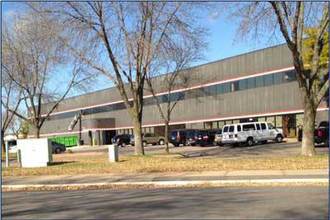 Project office opens
Project staff begin working toward start of METRO Blue Line Extension in 2021
Photo Right: The Crystal Gallery shopping center, location of the Blue Line Extension project office.
Engineers and other technical staff from the Metropolitan Council’s Blue Line Extension Project Office moved into their new quarters in the Crystal Gallery Shopping Center in January 2015 to begin designing a 13-mile extension of the region’s first light rail transit line.
The location at 5514 West Broadway Avenue in Crystal is accessible to transit and near the Blue Line Extension route, making it convenient for the public and project partners to attend meetings.
Before heavy construction can begin in 2018, engineers and technical staff will work with staff from the five corridor communities of Minneapolis, Golden Valley, Robbinsdale, Crystal and Brooklyn Park, as well as Hennepin County, to resolve technical issues, develop engineering plans, secure the municipal consent process and finish the environmental review.
|
Project Schedule
2014 - 2016 Project Development
2016 Environmental/Municipal Consent
2017 Engineering
2018 Full Funding Grant Agreement
2018 - 2020 Heavy Construction
2021 Passenger Operations
How the Blue Line Extension will help connect the region
New line will aid reverse commuters, address growing transit needs and serve diverse populations
As currently planned, the 13-mile line with 10 to 11 new stations and Target Field Station would extend through north Minneapolis, Golden Valley, Robbinsdale and Crystal to Brooklyn Park. Planners expect the primarily at-grade double-tracked line will have 27,000 average weekday riders by 2030. The line would begin revenue service in 2021.
It will connect activity centers, including the Target North corporate campus, North Hennepin Community College, downtown Robbinsdale, Courage Kenny Rehabilitation Institute and downtown Minneapolis, as well as provide a one-seat ride on the existing Blue Line to the VA Medical Center, Minneapolis-St. Paul International Airport and Mall of America.
The Blue Line Extension will connect Minneapolis and the northwest communities with the region’s system of transitways. They include existing LRT on the METRO Blue and Green lines, future LRT on the METRO Green Line Extension, bus rapid transit on the METRO Red Line, the Northstar commuter rail line and local and express bus routes.
The line will improve reverse commutes for Minneapolis riders and transit options for residents from northwest communities. The Blue Line Extension also will help meet the Metropolitan Council’s equity goals by building on other transit investments in north Minneapolis and will help connect racially and ethnically diverse residents throughout the corridor to job concentrations across the region.
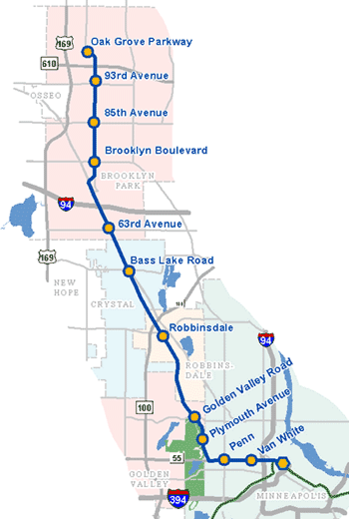 |
|
Extending the Blue Line
The route of the Blue Line Extension will follow the existing Highway 55 and BNSF freight rail corridor.
Starting at Target Field, the line will follow Highway 55.
Near Theodore Wirth Park, the line will turn north to folllow the BNSF freight railroad corridor through Golden Valley, Robbinsdale and Crystal.
At 73rd Avenue, the line will cross Bottineau Boulevard, and will then follow East Broadway Avenue.
The new line will improve access to North Hennepin Community College and the new Hennepin County regional library at 85th Avenue.
The Blue Line Extension will end just north of Highway 610 in Brooklyn Park, near the Target North Campus.
To learn more about the route, watch the Bottineau Transitway route visualization video at www.BlueLineExt.org.
|
Preparing for growth
The Blue Line Extension is needed because traffic congestion is expected to intensify, and current transit service in the project area offers a limited number of travel-time competitive alternatives to personal vehicles.
“Without major transit investments, it will be difficult to effectively meet the transportation needs of people and businesses in the corridor, mitigate highway traffic congestion and achieve the region’s goal of doubling transit ridership by 2030,” Metropolitan Council Chair Adam Duininck said.
Communities served by the Blue Line Extension are expected to grow by 110,000 people by 2040. Meanwhile, 14 percent of households in the project area do not own a vehicle, according to U.S. Census Bureau figures. In parts of north Minneapolis, more than half of the households lack cars.
Serving diverse communities
In some project area communities, senior citizens make up a larger share of the population than they do in the overall regional population. With senior populations in the region forecast to grow by 120 percent during the next 20 years, providing fast and reliable transit like the Blue Line Extension is important to help these seniors age in place.
About half of the corridor’s residents are people of color, and the project area communities are some of the region’s most rapidly diversifying areas. Languages spoken by the corridor’s residents include various African languages, Chinese, French, Hmong, Lao, Spanish and Vietnamese. The corridor is also home to many families recently arrived from Africa, including people from Ethiopia, Kenya, Liberia, Nigeria, and Somalia.
Years in the making
Studies of the Bottineau Transitway date back to the late 1980s.
The Hennepin County Regional Railroad Authority has been the lead local agency since 2007. The railroad authority, in partnership with the Metropolitan Council, local governments, and community organizations analyzed several routes and transit modes before selecting LRT and a route that received resolutions of support from all city councils and Hennepin County. The Federal Transit Administration approved the project to enter the New Starts Project Development phase in August 2014 at which time Metropolitan Council became the lead local agency.
Help shape the future of the Blue Line Extension
Being involved in 2015 is crucial for the public to inform engineering and the environmental review process.
Ways to get involved include attending periodic open houses and monthly meetings of the Community Advisory Committee, Business Advisory Committee and Corridor Management Committee, which is made up of elected officials and two members of the Blue Line Coalition. Project engineers use these committees’ advice to understand the public’s needs and inform their designs. The Metropolitan Council considers the committees’ recommendations when making decisions about the project.
Outreach staff also will identify community events where they can share the latest project information to reach busy people who cannot attend meetings.
Involvement starts by signing up for emails of the project newsletter, news releases and meeting announcements.
Sign up for news, meeting announcements
To be notified about upcoming meetings and receive project news, go to link to E-Newsletter Signup section at the bottom left of the project’s home page at www.BlueLineExt.org, enter your email address and choose the Committees and News sections in the left column.
Consider joining an advisory committee
The project office will seek appointments from communities for its Community and Business Advisory Committees.
“The input we receive from the businesses and residents is invaluable as we look to move the project forward,” said Sam O’Connell, manager of public involvement for the project.
The Business Advisory Committee will meet approximately once a month in the morning to accommodate the schedules of business people while the Community Advisory Committee will meet approximately once a month in the evening. Each committee will provide direct feedback on designs, help share information with other stakeholders and ensure that a broad range of perspectives are considered through the decision-making process.
It is anticipated the initial kick-off meeting with the two advisory groups will occur in March 2015. For more information about the project’s advisory committees, visit the project’s website where you will find agendas, presentations and meeting summaries in the Committees section of www.BlueLineExt.org.
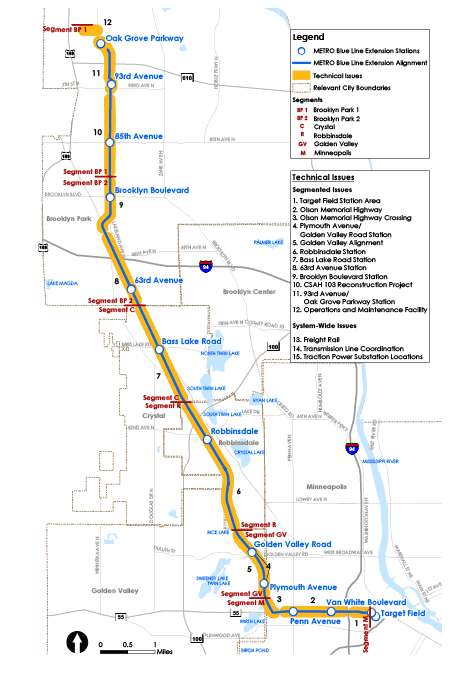 Resolving 15 technical issues a focus in 2015
Resolving 15 technical issues is a starting point for the project. These technical issues were compiled from the comments that were submitted on the Draft Environmental Impact Statement. Some of the issues are corridor wide, while others are specific to individual cities.
“How do we get these issues resolved? Some may be quick, some more involved and lengthy. We have formed Issue Resolution Teams staffed by Blue Line Extension Project Office engineers and other staff, our project partners, including the cities, the county, Minnesota Department of Transportation, Minneapolis Park and Recreation Board, watershed districts and the freight railroads. It’s aggressive, and we will be meeting weekly,” said Dan Soler, the project director, who previously worked at the project office for the METRO Green Line.
One technical issue is whether the line will have 10 or 11 new stations. Planners are studying both Golden Valley Road and Plymouth Avenue/Theodore Wirth Regional Park stations.
A detailed list of all 15 technical issues shown on this map is provided below.
|
Blue Line Extension Technical Issues
The locations of the technical issues listed below are shown on the map above. The Schedule column shows the anticipated time period of resolving the issues, for example "Q3 2015" indicated the third quarter of 2015.
Segment/Issue/Schedule
M-1: Target Field Station Connection
-
7th St. intersection design Q3 2015
M-2: Olson Memorial Highway
-
I-94 Interchange operations Q3 2015
-
Design treatment Q1 2015
-
Penn Ave. intersection operations Q3 2015
-
Median tree impacts Q3 2015
M-3: Olson Memorial Hwy. Crossing
-
Right-of-way pinch point Q3 2015
-
Bassett Creek floodplain impacts Q3 2015
-
Poor soils through watershed Q2 2015
GV-4: Plymouth Ave./Golden Valley Rd. Station
-
Station location Q1 2015
-
Parking Q2 2015
GV-5: Golden Valley Alignment
-
Bassett Creek floodplain impacts Q3 2015
-
Poor soils Q2 2015
-
Theodore Wirth Park property impacts Q4 2015
R-6: Robbinsdale Station
-
Park-and-ride, bus transit hub Q2 2015
-
At-grade crossing at 39½ – 40th Aves. Q3 2015
-
Grade-separated pedestrian crossings of LRT tracks Q3 2015
-
Traffic impacts at 42nd Ave. crossing Q3 2015
-
Noise and visual impacts Q3 2015
C-7: Bass Lake Road Station
-
Station access via all modes Q1 2015
-
Quiet zone for at-grade crossings Q3 2015
-
Parking/drop-off areas Q2 2015
-
Vera Cruz/West Broadway intersection Q3 2015
BP2-8: 63rd Ave. Park-and-Ride
-
Park-and-ride expansion Q1 2015
BP2-9: Brooklyn Boulevard Station
-
73rd Ave. crossing Q1 2015
BP1-10: Hwy. 103 Reconstruction Project
-
Coordination with Hennepin Co. reconstruction project Q1 2015
-
Traffic impacts Q2 2015
-
Operating assumptions Q1 2015
-
Maintenance responsibility 2016
BP1-11: 93rd Ave./Oak Grove Pkwy. Station
-
Park-and-ride Q1 2015
-
Station configuration Q1 2015
BP1-12: Operation & Maintenance Facility
-
Site selection and size Q1-Q2 2015
13: Freight Rail
-
Design issues Q2 2015
-
Right-of-way acquisition Q4 2015
14: Transmission Line Coordination
-
Location and support structures for Xcel Energy high voltage transmission lines Q2 2015
15: Traction Power Substations
-
Locations for traction power substations Q4 2015
Finishing environmental review is another goal for 2015
The Metropolitan Council selected HDR Inc. as the environmental review consultant for the Blue Line Extension Project.
HDR will work with the Metropolitan Council, Federal Transit Administration and other stakeholders to complete the environmental review process.
Environmental review includes:
- Evaluating potential impacts and benefits of the project in coordination with Kimley-Horn, the engineering services consultant, as it conducts preliminary engineering
- Documenting these results in a Final Environmental Impact Statement (the Draft EIS was published in April 2014) to be published in 2016
- Responding to comments submitted on the DEIS during the comment period
- Evaluating refinements, if any, to the locally preferred alternative based on engineering activities
- Identifying measures to avoid, minimize or mitigate adverse impacts of the project
Sambatek: Helping build the Blue Line Extension
Sirish Samba’s journey to working on Twin Cities LRT projects started outside a bank in India
Sirish Samba had just finished an undergraduate engineering degree in India in the early 1990s and wanted to attend a university in the United States to earn his master’s degree. But he had grown up the only son in a modest family of seven children and couldn’t afford the move.
“Only the privileged in India go study abroad,” said Samba, the son of an Indian Railways guard, the British term for conductor.
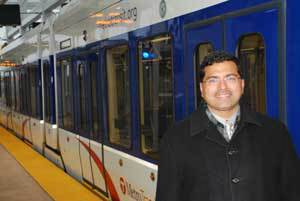 Photo Right: Sambatek CEO Sirish Samba
Today, Samba, 44, is the CEO of Sambatek, a 100-employee engineering firm in Minnetonka. The firm is working on the METRO Blue Line Extension LRT Project and has worked on the METRO Green Line and Southwest LRT (METRO Green Line Extension) Projects. Sambatek has thrived in part through its participation in the state’s Disadvantaged Business Enterprise (DBE) program, but Samba also emphasizes his company’s professional work and experience as keys to its growth.
Samba’s path to employment in the United States and the helm of Sambatek didn’t happen by chance.
For a solid month when he was 21, Samba sat outside the bank in southern India, trying to talk to a key banker each day as he entered the building. Eventually, the banker agreed to meet with him. He informed Samba that the bank didn’t provide student loans.
Samba, a strong student, had already heard from South Dakota State University in Brookings, S.D. The school had accepted him into its master’s program for an engineering degree and had agreed to let him pay in-state tuition. But Samba needed a $4,000 loan to help him travel to the United States and enroll at South Dakota State. Once there, he planned to get a job to help pay his way.
“Every day I would go back to the bank and ask for the loan,” Samba said.Seeing Samba’s persistence, the banker relented and provided the loan.
He gained valuable experience working on high-profile projects, including wastewater treatment facilities for the growing city of St. Michael, the Arbor Lakes development in Maple Grove and the Water Park of America in Bloomington.
But the ownership of MFRA was in flux. The former CEO decided to retire in 2000 and pass the firm to four senior managers. After an appraisal, though, he decided to sell the business to an investor. In 2005, MFRA changed ownership again when it was sold to a private equity firm.
As the recession hit, MFRA, which was well known in the Twin Cities as a land development company, found itself burdened with debt. Over time, Samba took a larger role in righting the company’s finances and eventually ended up the majority owner supported by other employee-owners.
The restructured company operated as MFRA and still did development work, but Samba was seeking more civil-engineering related work as well.
At a convention in 2009, Samba met Tracey Jackson, a senior equal opportunity consultant for Metro Transit, who works with DBE firms. Requirements for participating in the DBE program involve limits on personal net worth (less than $1.32 million), a business-size standard set by the Small Business Administration of less than $17.4 million in annual gross receipts and be at least 51 percent minority or woman owned.
For the Green Line Extension LRT Project’s advanced design contract and for the Blue Line Extension engineering contract, the DBE goal is 19 percent.
Samba was apprehensive about participating in the DBE program, but the company qualified and was looking to grow to rebound from the recession.
In recent years, Sambatek won a contract for work on the Interchange project in downtown Minneapolis where all of the LRT lines and Northstar commuter rail come together. His firm is doing survey work on the Blue Line Extension LRT Project. Sambatek was also awarded a master contract from the Metropolitan Council, which essentially puts the firm on call for a wide range of future work.
|
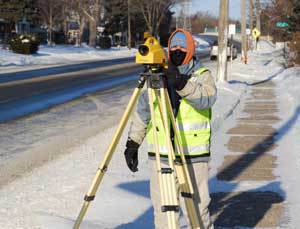 Paul Danielson, a senior vice president with Kimley-Horn, a nationally known design consulting firm, was introduced to Samba when Kimley-Horn was pursuing preliminary engineering work for the Southwest LRT Project. Surveying was Sambatek’s primary work on the project, Danielson said. “But what’s worked out well is their willingness to jump in and do just about anything we’ve asked,” he said.
That included support for visual simulations along the Southwest LRT alignment, architectural renderings and storm water management analysis.
Photo Above: Jeremy Honga of Sambatek does survey work on the Blue Line Extension LRT Project along Broadway Avenue in Robbinsdale
“They were our number one DBE firm on Southwest LRT,” Danielson said. “They became an extension of our staff.”
Sometimes the two firms compete on projects, sometimes they’re partners, Danielson said. “We trust each other enough to know that we’ll be team partners and at times we might compete head-to-head,” he said.
In 2014, the company changed its name to Sambatek and moved to new space in Minnetonka, near Interstate 494 and Highway 62. “It shows our confidence in the future of the company,” Samba said.
Sambatek is also opening an office in Bismarck, N.D., to support highway projects there.
Samba, who is married with three children, says his success in Minnesota paid dividends back in India. Years ago, he paid back the student loan that made it possible for him to attend South Dakota State. “Even now, when I go back, I sometimes visit with (the banker) because I’m a very grateful person,” Samba said.
His work in the United States has also allowed him to help all of his sisters get married in India, where paying a dowry to the groom’s family is the norm. “That’s where I get my drive,” Samba said, referring to his ability to help his family back home. If all else is failing, he said his background “teaches me to not take no for an answer.”
Samba is a naturalized citizen and calls Minnesota home now. “I’m grateful to the country and its people, and its systems that provide equal opportunity,” he said. “For a son of a railroad guard to be a consultant for an LRT system, it’s an incredible honor.”
|
Visit www.BlueLineExt.org for the latest project news, event announcements and information on the project.
On the website, you can also sign up to receive news updates by email in the E-Newsletter signup section at the bottom left of the home page.
About the project
The planned METRO Blue Line Extension (Bottineau) light rail transit project will operate about 13 miles northwest from downtown Minneapolis through north Minneapolis, Golden Valley, Robbinsdale, Crystal and Brooklyn Park, drawing riders northwest of Brooklyn Park. The proposed alignment will have 10 or 11 new stations in addition to Target Field Station where it will continue as the METRO Blue Line, providing one-seat rides to Minneapolis-St. Paul International Airport and the Mall of America. It will connect Minneapolis and the region’s northwest communities with existing LRT on the METRO Green Line, future LRT on the METRO Green Line Extension (Southwest LRT), bus rapid transit on the METRO Red Line, the Northstar commuter rail line and local and express bus routes.
The Metropolitan Council will be the grantee of federal funds and is charged with building the line in partnership with the Minnesota Department of Transportation. The Blue Line Extension Corridor Management Committee, which includes local officials from Hennepin County, Golden Valley, Robbinsdale, Crystal, Brooklyn Park, Brooklyn Center, Minneapolis and the Minneapolis Park and Recreation Board as well as community representatives, provides advice and oversight. Funding is provided by the Federal Transit Administration, Counties Transit Improvement Board (CTIB), state of Minnesota and Hennepin County Regional Railroad Authority (HCRRA).
|